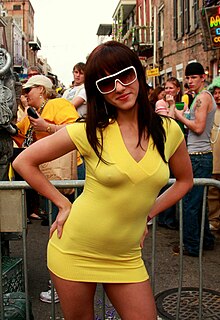| Revision as of 05:33, 4 June 2020 editALG (Tony Nexus) (talk | contribs)1 edit DJ's← Previous edit | Revision as of 05:34, 4 June 2020 edit undoMaterialscientist (talk | contribs)Edit filter managers, Autopatrolled, Checkusers, Administrators1,994,292 editsm Reverted edits by ALG_(Tony_Nexus) (talk): not providing a reliable source (WP:CITE, WP:RS) (HG) (3.4.10)Tags: Huggle RollbackNext edit → | ||
| Line 6: | Line 6: | ||
| == Musical style and legacy == | == Musical style and legacy == | ||
| Juliana's started out playing ] then quickly following popular trends to ]. The Juliana's producers published a series of compilation CDs which were popularizing techno in Japan. The album sales were an essential part of the business concept as the club was never very profitable on its own. |
Juliana's started out playing ] then quickly following popular trends to ]. The Juliana's producers published a series of compilation CDs which were popularizing techno in Japan. The album sales were an essential part of the business concept as the club was never very profitable on its own. | ||
| The original Julianas Tokyo DJ’s where | |||
| John Robinson, ALG (now Tony Nexus), David (3D)Ward and Johnny Proctor although other DJs had stints at the club they were the main DJ’s | |||
| ALG was know for keeping the music and ideas fresh and his amazing light shows, John Robinson (Japans first ever supper star DJ) was famous for getting the crowd hyped up and performing his own hit tracks . David Ward was the technical wizard with Producer’s and light technician’s Masao Passion Hotta and Gun | |||
| The Julianas Tokyo compilations where styled and compiled from the DJs mix set’s and play list and, included voice overs from the DJ’s. | |||
| The club was also know for its cutting edge approach to entertainment and regularly featured and hosted artist from all over the world, including Prodigy and Take That performed their first ever live gigs in Japan. | |||
| == Cultural impact == | == Cultural impact == | ||
| Line 46: | Line 37: | ||
| ] | ] | ||
| ] | ] | ||
| ] | ] | ||
| ] | ] | ||
Revision as of 05:34, 4 June 2020
For the pizzeria located in Brooklyn, see Juliana's Pizza.
Juliana's, also known as Juliana's Tokyo (ジュリアナ東京), was a Japanese discothèque that operated in Shibaura, Minato, Tokyo from May 15, 1991 till August 31, 1994. It was famous for its dance platforms, on which office ladies dressed in "bodycon" (abbr. (wasei-eigo): "body conscious" (ボディコン, bodikon, "sexually flattering clothing")) clubwear would congregate, as amateur go-go dancers (professionals were also employed). The club was produced by Masahiro Origuchi for the British leisure services group Wembley PLC, and Nissho Iwai Corporation, the Japanese general trading company (now part of Sojitz).
Musical style and legacy
Juliana's started out playing Italo house then quickly following popular trends to Hardcore techno. The Juliana's producers published a series of compilation CDs which were popularizing techno in Japan. The album sales were an essential part of the business concept as the club was never very profitable on its own.
Cultural impact
The Juliana culture represented a hedonistic youth culture which had only recently arrived in Japan. The gyaru subculture found its expression in high school girls and office ladies alike transforming into Juliana girls in the evening, whereas men often came to the club in business suits.
References
The club "Disco Queen" in chapters 18, 19, and 21 of the rugby manga No Side by Ikeda Fumiharu (池田文春) is a reference to Juliana's, down to the white feather fans used by the dancers.
The club Juliana's is mentioned several times into the shōjo manga Hana Yori Dango by Yoko Kamio (神尾 葉子).
See also
- Herve Leger—the fashion house founded by the creator of the body-con dress
Notes
- Brand, Tokyo Night City, p. 34.
- Jim Breen's WWWJDIC, ボディコン Archived 2012-06-30 at archive.today.
- Chaplin, Sarah. Japanese Love Hotels: A Cultural History. Routledge contemporary Japan series, 15. London: Routledge, 2007, p. 135. ISBN 978-0-415-41585-9, ISBN 978-0-203-96242-8.
- Schilling, Mark (1997). The Encyclopedia of Japanese Pop Culture. Weatherhill. pp. 76–78. ISBN 0-8348-0380-1.
- Kawakami, "Survivors: two approaches to survival in Japan's unkind economy".
- Trends in Japan, "Disco Icon Sets Out To Conquer Nursing Care".
- Schilling, The Encyclopedia of Japanese Pop Culture, p.77.
- ノーサイド (No Side, ("Nō Saido")) volume 3, pp. 32–3, 35, 66–68, 111–123. ISBN 4-08-875070-5.
- PRISMS: The Ultimate Manga Guide, No Side. Accessed 10 August 2008.
- Fujino, Chiya. "Her Room". In Ozeki, Ruth, and Cathy Layne. Inside and Other Short Fiction: Japanese Women by Japanese Women; with a foreword by Ruth Ozeki; compiled by Cathy Layne, p. 144. Tokyo: Kodansha International, 2006. ISBN 4-7700-3006-1. Accessed 10 August 2008.
References
- Associated Press. "Juliana's craze ceases", September 1, 1994. Accessed 2 July 2017.
- Brand, Jude. Tokyo Night City. Rutland, Vermont: Charles E. Tuttle Company, 1993. ISBN 0-8048-1896-7.
- Kawakami, Sumie. "Survivors: two approaches to survival in Japan's unkind economy: meet the fighter and the surfer - H.I.S. president Hideo Sawada and Goodwill Group CEO Masahiro Origuchi". Japan, Inc., December 2002. Accessed 10 August 2008.
- Schilling, Mark. "Juliana's" in The Encyclopedia of Japanese Pop Culture. New York: Weatherhill, 1997. ISBN 0-8348-0380-1.
- Sterngold, James. "A Night on the Town in Tokyo". The New York Times, October 18, 1992. Accessed 2 July 2017.
- Trends in Japan. "Disco Icon Sets Out To Conquer Nursing Care: Former Club Producer Ventures Into New Territory", June 30, 2000. Accessed 10 August 2008.
35°38′47″N 139°45′12″E / 35.64639°N 139.75333°E / 35.64639; 139.75333
Categories: